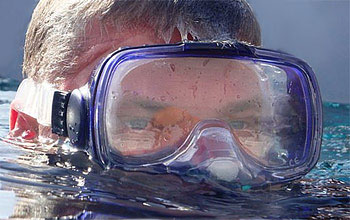
Picture this: You’ve traveled to your dream snorkeling or scuba diving destination, eager to explore the mesmerizing underwater world. However, your excitement turns to frustration as your mask fogs up, obstructing your view and spoiling your underwater adventure.
A foggy mask not only hinders your experience but can also pose safety risks. Clear vision is essential for appreciating the aquatic wonders and staying alert to signals from dive buddies or potential dangers.
Fear not! In this comprehensive guide, we will explore several effective methods to prevent your snorkel or scuba mask from fogging up. Whether you prefer toothpaste, baby shampoo, anti-fog products, or even a controlled use of fire, we’ve got you covered. Before delving into these methods, let’s first ensure you have a mask that fits you perfectly, as this is crucial for avoiding fogging issues.
Ensure a Properly Fitting Mask

Before embarking on your fog-free journey, it’s imperative to have a mask that fits your face snugly. No matter how effective your defogging techniques are, an ill-fitting mask will compromise their effectiveness. Here’s how to ensure a proper fit:
Consider Face Size
Take your face size into account when selecting a snorkel mask. If you have a smaller face, opt for masks designed for small and narrow faces, as they offer a higher chance of creating a secure seal.
Adjustability
Masks come with adjustable straps, but exploring different brands and types is also essential. If possible, visit a dive shop in person to try on various masks. When shopping online, rely on customer reviews to gauge the fit.
Mask Seal Test
Conduct a quick test to check the mask’s seal integrity. Hold the mask against your face with one finger (without using the straps), inhale through your nose, and remove your finger. If the mask remains stuck to your face without support, the seal is strong.
Skirt Size
Choose a mask with a large skirt, providing ample surface area for a secure seal. Ensure that facial hair doesn’t hinder the mask’s ability to seal.
Comfort
Opt for a mask with a comfortable skirt, as you’ll be wearing it for extended periods. Additionally, consider a clear or black skirt based on your preference for increased vision or glare reduction. A quality dive mask with a soft silicone skirt typically costs between $50 and $100.
Steps to Prevent Fogging
Now that you have the right mask, let’s explore the steps to prevent fogging.
Step 1: Defog the Mask with a Lighter
This step may sound intimidating, but it’s a highly effective way to prevent fogging, especially for masks with glass lenses. Before proceeding, ensure your mask has glass lenses, as plastic lenses require a different approach. Here’s how to defog your mask with a lighter:
Caution: This method carries a slight risk of damage or injury, so exercise caution, especially if you’re assisting a child.
- Identify Glass Lenses: Verify that your mask has glass lenses. This technique is not suitable for masks with plastic lenses.
- Inside Lens Only: Apply heat exclusively to the inside of the lens, avoiding contact with the silicone skirt.
- Burning Process: Hold a flame to the glass, moving it in a circular motion. You’ll notice the protective silicone layer turning black as it burns off.
- Cool Down: Once the silicone is burned off, allow the glass lens to cool naturally. Avoid exposing it to cold water immediately, as rapid temperature changes may cause the glass to crack.
This process effectively minimizes the risk of fogging in your mask. Ensure you follow safety precautions and keep the flame away from the silicone skirt.
Step 2: Clean with Toothpaste or Dish Soap (For Plastic Lenses)
Regular maintenance of your snorkel or scuba mask is essential to prevent fogging. Follow these steps to clean your mask:
For Glass Lenses: Use toothpaste and a toothbrush. For Plastic Lenses: Use dish soap, a soft brush, or cloth.
Here’s how to clean your mask effectively:
- Scrubbing: Apply toothpaste (for glass lenses) or dish soap (for plastic lenses) to a toothbrush or soft brush.
- Cleaning: Scrub the mask’s lens thoroughly, focusing on removing any remaining residue or factory coatings. Avoid using your fingers, as they can transfer oils onto the lens.
- Rinsing: After thorough scrubbing, rinse the mask with hot water to remove all cleaning agents.
For a new mask, repeat this cleaning process multiple times before using it in the water. Be extra cautious when cleaning masks with plastic lenses to prevent scratches.
Step 3: Apply Anti-Fog or Baby Shampoo

Before venturing into the water, apply an anti-fog product to your mask to maintain clear visibility. Opt for biodegradable and reef-friendly options to minimize environmental impact. Here are the steps to apply anti-fog or a homemade solution using baby shampoo:
- Commercial Anti-Fog: Follow the instructions provided with the anti-fog product. These solutions come in convenient, travel-sized bottles that fit in your BCD pocket.
- Homemade Anti-Fog: Create a mild solution by mixing approximately a dozen drops of baby shampoo with a few ounces of water. Baby shampoo is preferred for its eye-safe properties.
- Application: Transfer the solution to a spray bottle for easy application. Thoroughly spray the mask’s lens until it is completely covered, and gently swish it around. Avoid touching the lens with your fingers. Finish with a quick rinse using fresh or saltwater.
Step 4: Wear the Mask Immediately
To ensure a fog-free experience, it’s crucial to wear your mask promptly after applying the anti-fog solution. Minimize moisture inside the mask, which can lead to fogging, by keeping your face dry. Seal the mask tightly, and refrain from exhaling into it unless absolutely necessary, as this introduces moisture.
For optimal results, wear a dry mask on a dry face and avoid removing the mask while in the water. Following these steps correctly should prevent fogging issues.
Step 5: Last Resort – Spit Solution
While it’s rare, there may be instances where your mask still fogs up while in the water. In such cases, the spit solution can serve as a last resort:
- Spit Application: Spit inside the mask and ensure the entire lens is coated. Avoid using your fingers and keep swishing the saliva around.
- Repeat as Needed: If necessary, continue spitting inside the mask and swishing the saliva to coat the lens adequately. You can mix the spit with a bit of saltwater to enhance its effectiveness.
This may seem unconventional, but spit is an effective anti-fog solution in emergencies.
Preventing Fogging in Full-Face Masks
While full-face masks are designed to minimize fogging by directing airflow across the lens when you inhale, they may still experience occasional fogging. Follow the same cleaning steps mentioned above for full-face masks. However, exercise extra caution when cleaning plastic lenses to avoid scratching, and refrain from using spit as a defogging solution due to the larger surface area.
Understanding the Science Behind Fogging
To effectively combat fogging, it’s essential to understand why it happens in the first place. Fogging occurs due to a phenomenon known as condensation, which you might have experienced on home or car windows during colder weather. This same principle applies to your snorkel or scuba mask when there’s a significant temperature difference between the interior and exterior environments.
When you’re underwater, your mask cools down due to the surrounding water temperature. As you surface, exposing the mask to the sun, the warm air inside the mask meets the cold lens, leading to condensation or fogging. To minimize this effect and keep your mask clear, consider the following strategies:
- Face Away from the Sun: After surfacing, make it a habit to face away from the sun when putting on your mask. This simple step prevents the “hothouse effect” from heating the air inside the lens.
- Minimize Mask Removal: To reduce moisture inside the mask, avoid removing it while in the water whenever possible. Keeping the mask sealed on your face helps maintain a clear view.
By applying these principles and the defogging methods discussed earlier, you can enjoy uninterrupted, crystal-clear visibility during your snorkeling or diving adventures.
Conclusion
Don’t let a foggy mask ruin your underwater experiences! Whether you’re snorkeling or scuba diving, mastering the art of keeping your mask clear is essential. By following these steps, you can ensure that your mask remains fog-free.









